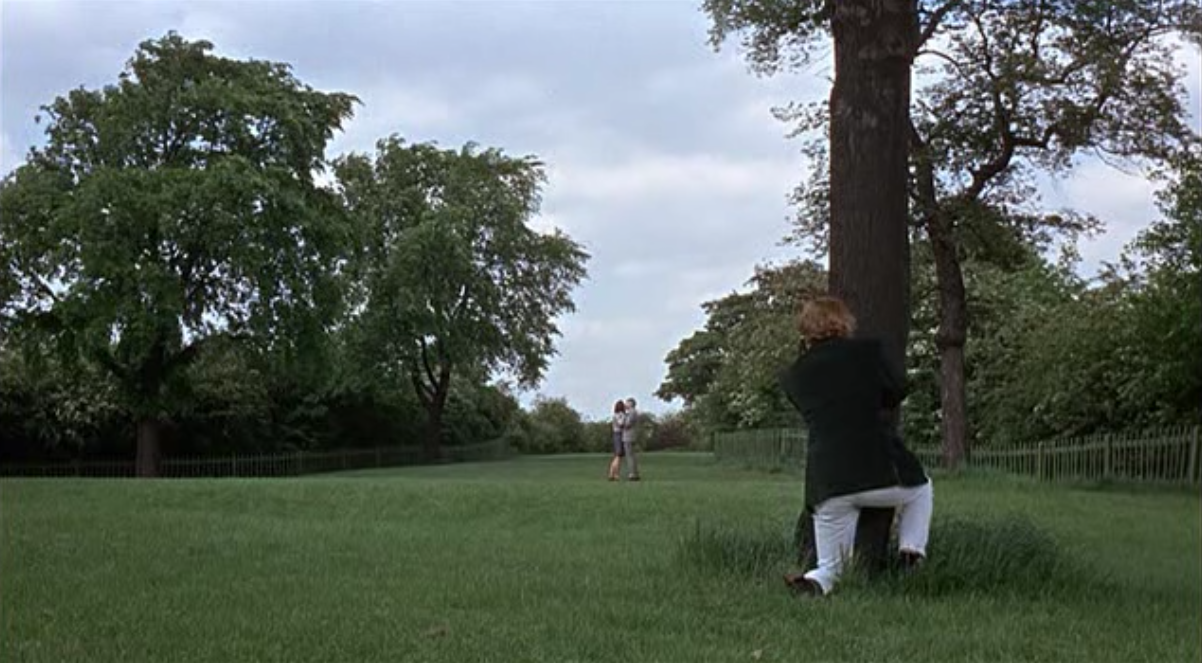If asked to choose a particular sound that defined London in cinema, it would not be the bustling noise of traffic or an iconic piece of soundtrack music. It would, in fact, be the very simple but endlessly mysterious sound of the wind rustling through the trees in Michelangelo Antonioni’s Blowup (1966).
Having visited all of the locations of the film last summer for the British Film Institute, it was a surprise to find, when visiting Maryon Park in Charlton where much of the film’s famous sequences were shot, that Antonioni and his sound recordist Robin Gregory had merely emphasised something that was already there rather than creating an impressionistic illusion of diegetic sound.
This was doubly surprisingly considering how much Antonioni augmented the visuals of his locations, famously painting the grass in the park and the tarmac on the road so that it looked exactly as he wanted it. This emphasis on the breeze, and its grounding in a very particular everyday reality, is where much of the power of these sequences in the film is arguably derived.
In narrative terms, the park sits at the heart of the film, though ironically is geographically at the very edge of the rest of the film’s action. Thomas (David Hemmings), a photographer, pays a fleeting visit to the park after perusing in a nearby antique shop. He slowly echoes the footsteps of a pair of lovers whom he photographs, only to be confronted by the woman, Jane (Vanessa Redgrave), who doesn’t want the photos developed.
The film revolves around the back-and-forth journey of these photos before Thomas realises, after developing the reel and gradually blowing up the photos, that he has accidentally captured a murder. He then visits the park several times, first finding the body of the murdered man and then finding it disappeared before finally disappearing himself after a watching a group of mimes play tennis in the park’s public court. Maryon Park is, in other words, at the centre of the narrative vortex of the film, with each visit spitting Thomas back out as irreparably changed, even when he fails to realise such a change to have occurred.
For all of these moments in the park, the sound of the wind rustling through the trees is heightened, being almost the only sound to occur there apart from the occasional snap of Thomas’ camera and the final game of mime tennis (which, itself, is a puzzling moment in that an imaginary game eventually produces real sounds).
Antonioni had relied on this rustling effect before, in particular in the Rome set entry for his Alienation Trilogy L’eclisse (1960), but it feels more apt for London, not least because the city has more trees standing than Italy’s capital.
The soundscape hints towards an otherness in the space, one that is away from the hectic noise of Yardbirds gigs, fashion shoots, chaotic threesomes and drives around Notting Hill’s streets. For a film with a notably famous soundtrack, one performed by Herbie Hancock, its virtual absence throughout in all but the very final moment (along with the odd moment of being listened to by characters on record players) raises questions about what this sound of the breeze through the trees is doing to the film as a whole.
In Julio Cortázar’s original 1963 short story, the nature of the wind gets a mention and, though originally set in Paris, it is worth quoting as it at least highlights its deliberate inclusion. ‘It’s rare that there is wind in Paris,’ wrote the author, ‘and even less seldom a wind like this that swirled around corners and rose up to whip at the old wooden Venetian blinds behind which astonished ladies commented variously on how unreliable the weather had been these last few years.’
It seems that Antonioni ran with this aspect. Thomas initially sees it as representing some sort of peace and contentment away from his hectic photography studio rather than anything particularly meaningful. When he mentions the photos he has taken in the park to his manager Ron (Peter Bowles) (importantly before he has developed the reel and seen what is on it), he mentions this calmness as a defining factor. He is at that point unaware of the change that has taken place since he visited the park. The continual transition of Thomas’ own realisation – a realisation of both the inane qualities of his life and what he has really seen in the park – becomes overt and eventually unavoidable.
The sound of wind rustling the trees of Maryon Park becomes a haunting sonic leitmotif for this transition of character; a realisation of something was missed the first time round. The link between this idea and the character comes from an engagement with the outside world, where the park and Thomas develop a symbiotic relationship far beyond what he initially perceived would be the outcome from his casual visit to snap away a few rolls of film.
The final irony of this is that such a realisation ultimately destabilises the character to the point where he disappears. When the final end titles of the film appear, Thomas fades from the park; the awareness of the mime of his current existence beyond salvaging. Antonioni shows the wonderful logic of this moment as, instead of the breeze in the trees dominating the soundtrack, the Hancock score plays instead, drowning out the diegetic sound just as the realisation of his non-existence has effectively drowned him out; so much so that he fades from the grass and into the breeze.


